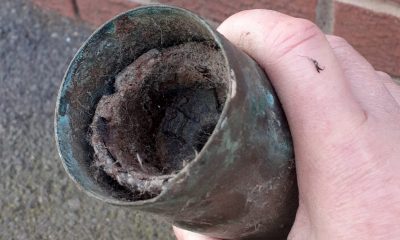Test predicts spread and return of deadly skin cancer Melanoma
Published
2 years ago onBy
Talker News
By Stephen Beech via SWNS
A new test that reliably predicts the spread or return of the most deadly form of skin cancer has been developed by British scientists.
It offers reassurance for patients diagnosed with early-stage melanoma.
Melanoma is increasing worldwide and every year more than 16,000 people in the UK and 96,000 people in the United States are diagnosed with the cancer.
The pioneering technological advance follows a scientific breakthrough by the team in understanding the mechanism of skin cancer growth.
Newcastle University Professor Penny Lovat led the project in conjunction with the University's spin out company AMLo Biosciences.
By applying the test - called AMBLor - to the standard biopsy of the primary melanoma on its removal, patients who are at low risk of the disease reoccurring or spreading can be identified.
A referral service is now available where sections from a patient’s melanoma can be posted to a lab for analysis.
The test identifies a patient’s true risk of disease progression and provides anyone diagnosed with a non-ulcerated early-stage melanoma - accounting for around 75 per cent of all new diagnoses - more accurate information about the risk of the disease spreading.
Now the scientists have demonstrated the mechanism in the skin which underpins the test.

In the new research, published in the British Journal of Dermatology, the Newcastle team explain how early-stage melanomas at risk of spreading secrete a growth factor, TGFβ2 which causes the reduction, or downregulation, of the proteins AMBRA1 and Loricrin - both of which are found in the skin overlying the tumour.
The growth factor TGFβ2 also causes the loss of claudin-1 leading to loss of the integrity of the skin and facilitating ulceration.
Senior author Prof. Lovat said: “Like mortar and bricks holding together a wall, AMBRA1, Loricrin and Claudin 1 are all proteins key to maintaining the integrity of the upper layer of the skin.
"When these proteins are lost gaps develop - like the mortar crumbling away in the wall. This allows the tumor to spread and ultimately ulcerate which we know is a process associated with higher risk tumors.
“Our new understanding of this biological mechanism underpins the test we have available.”
Cory Inglis, 49, is one of the first patients about to have AMBLor used on his standard biopsy after a diagnosis of a melanoma on his back.
He said: “When you sit down with a dermatologist after the initial excision, you hear that it wasn’t a mole, it was a melanoma.
"You are in a state of fear. It’s overwhelming. At that moment a lot of the information that is provided is in very impenetrable, technical language. You ask yourself, what does it mean for me?
"To be able to have a test like this which provides you with result of the melanoma being low or at risk can help your medical team communicate the information in a way that is comprehensible, and importantly to help them to make the right subsequent decisions for you.
“A test, like AMBLor which tells you that your tumor is genuinely low risk helps significantly with the anxiety of an already very stressful situation.
“Patients will understand what a low-risk result means. If the result is a risk, it completely justifies the significant number of interactions that you will have with the dermatology team over a five year period.
"I don’t see any downside in providing the dermatology team with more information about your melanoma.”
Prof Lovat added: “Our test offers a personalised prognosis as it more accurately predicts if your skin cancer is unlikely to spread.
"This test will aid clinicians to identify genuinely low-risk patients diagnosed with an early-stage melanoma and to reduce the number of follow-up appointments for those identified as low risk, saving NHS time and money.”
Phil Brady, British Skin Foundation chief operating officer, said: “The development of the AMBLor test can alleviate stress and anxiety for patients caused by this potentially deadly skin cancer, whilst increasing efficiency and reducing costs to the NHS.”
Consultant dermatologist Professor Nick Levell added: “This new test for melanoma will help many people with skin cancer.
"People at low risk can be reassured and will not have to attend hospital so often for check-ups.
"This British Skin Foundation co-funded research is an important step forward in making care after melanoma more personal.”
Currently, primary tumors are removed by surgery and pathologists study the biopsy under the microscope to determine the stage the skin cancer is at and the risk of it spreading.
Even if defined as low risk, the patient is followed up in the clinic for as long as five years – and it is these patients that the test is able to identify.
The AMBRA1 and loricrin test is accredited by UKAS and is already available through a private referral service from the spin out company, AMBLo Biosciences.
The test involves tissue sections from the standard biopsy being sent in the post to the lab for analysis. The Newcastle team have also submitted an application for the test to be made available on the NHS.
Stories and infographics by ‘Talker Research’ are available to download & ready to use. Stories and videos by ‘Talker News’ are managed by SWNS. To license content for editorial or commercial use and to see the full scope of SWNS content, please email [email protected] or submit an inquiry via our contact form.
You may like


New breakthrough treatment boosts cancer-fighting cells


Signs of multiple sclerosis can show up in blood years before symptoms


Why baby sharks prefer swimming in shallow water


Scientist transforms climate change data into classical music


Breakthrough may help unlock way to prevent diabetes


Having this type of job could reduce risk of memory issues
Other Stories


New breakthrough treatment boosts cancer-fighting cells
The approach involves activating the immune cells in the body and "reprogramming" them to attack and destroy the cancer cells.


One-year-old can’t stop laughing during first ride at Disneyland
"We didn't expect him to love it that much."


Dad running marathon wearing chainmail weighing over 40 pounds
A dad is attempting to break the world record for the fastest marathon while wearing chainmail.


Hero saves elderly couple by dragging them out of burning car
The Good Samaritan jumped into action after spotting the fire on his way to work.


Bomb squad seals off town after ammunition shell donated to charity shop
Staff discovered the device in a bag of donations.
Top Talkers

 Parenting2 days ago
Parenting2 days agoSingle mom details struggles of feeding her 12 kids

 Broadcast4 days ago
Broadcast4 days agoOver 40% of Americans have no clue what a 401k is

 Broadcast3 days ago
Broadcast3 days agoHow hard is it for Americans to live sustainably?

 Broadcast1 week ago
Broadcast1 week agoGrocery shopping hungry is costing Americans this much

 Funny1 week ago
Funny1 week agoCops confused by crow mimicking police siren

 Shopping1 week ago
Shopping1 week agoGrocery shopping hungry costs Americans this much every trip

 Money4 days ago
Money4 days agoOver 40% of Americans have no clue what a 401k is

 Parenting1 week ago
Parenting1 week agoIt takes this many minutes for the average American kid to get bored
